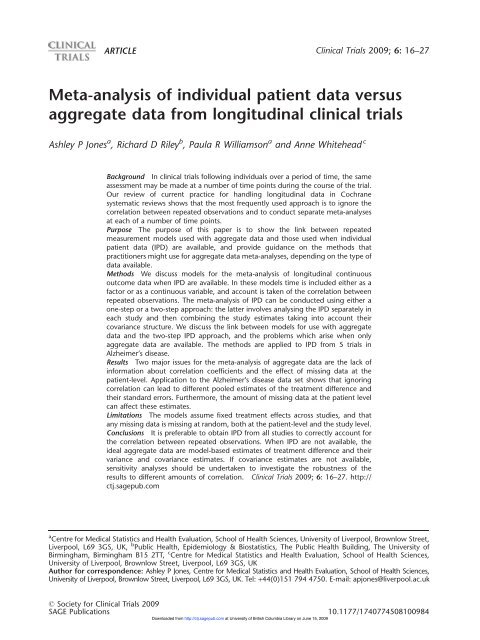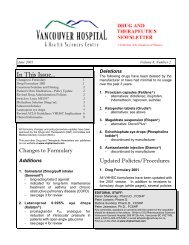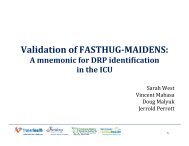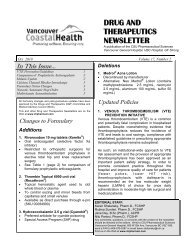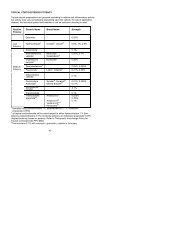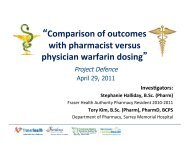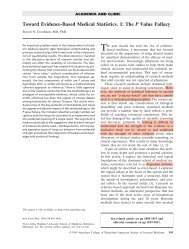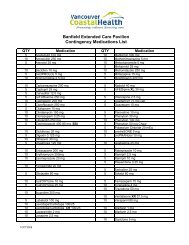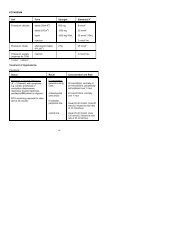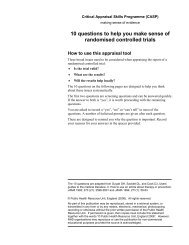Meta-analysis of individual patient data versus aggregate data from ...
Meta-analysis of individual patient data versus aggregate data from ...
Meta-analysis of individual patient data versus aggregate data from ...
Create successful ePaper yourself
Turn your PDF publications into a flip-book with our unique Google optimized e-Paper software.
IPD <strong>versus</strong> <strong>aggregate</strong> <strong>data</strong> in the meta-<strong>analysis</strong> <strong>of</strong> longitudinal trials 17IntroductionThe assessment <strong>of</strong> a <strong>patient</strong> who has a chroniccondition, for example cystic fibrosis or a neurodegenerativedisorder, <strong>of</strong>ten involves taking measurements<strong>of</strong> an outcome at a number <strong>of</strong> timepoints throughout the course <strong>of</strong> a trial. Such <strong>data</strong>are referred to as longitudinal <strong>data</strong> or repeatedmeasures <strong>data</strong>, and allow one to assess the changein an outcome over a period <strong>of</strong> time [1]. Whenmultiple trials <strong>of</strong> the same longitudinal outcomeexist, it is clearly important to synthesize the <strong>data</strong>across trials to facilitate evidence-based conclusions.However, the longitudinal nature <strong>of</strong> the<strong>data</strong> creates added complexity for those performingmeta-<strong>analysis</strong>. For example, it is common t<strong>of</strong>ind that the timing <strong>of</strong> the repeated measurementsvaries across trials. In this situation,a standard meta-<strong>analysis</strong> conducted at a specifictime point will usually be based on only asubset <strong>of</strong> the trials. Further, meta-analyzing eachtime-point independently may be inappropriate,as correlation exists between time-points. Thus amore complex meta-<strong>analysis</strong> that synthesizes alltrials and all time-points simultaneously, whilstaccounting for correlation, is potentially superior.Several authors have considered the meta<strong>analysis</strong><strong>of</strong> longitudinal <strong>data</strong> [2–4]. Most recently,Ishak et al. consider when only <strong>aggregate</strong> <strong>data</strong>are available <strong>from</strong> each study [4], such as themean treatment difference and its standard error ateach time-point. They propose models that accountfor the correlation between the multiple timepoints,and suggest the approach ‘may providebetter fit and possibly more precise summary effectestimates’ than approaches that ignore correlation.However, the authors note that they ‘encountereddifficulties in estimating the correlationparameters’, even when very simple correlationstructures were assumed, and could not confirm thebenefits <strong>of</strong> the proposed models since in theirexample ‘the true values <strong>of</strong> the parameters <strong>of</strong>the model were not known’. This highlightssome <strong>of</strong> the disadvantages <strong>of</strong> having only<strong>aggregate</strong> <strong>data</strong>, with the unavailability <strong>of</strong> withinstudycorrelations a major concern and limitation[5,6].In this article we consider the meta-<strong>analysis</strong> <strong>of</strong>longitudinal <strong>data</strong> using <strong>individual</strong> <strong>patient</strong> <strong>data</strong>(IPD) [7], where the original <strong>data</strong> <strong>from</strong> allparticipants in each trial are obtained and thensynthesized. We show that availability <strong>of</strong> IPDallows the correlation between multiple timepointsto be calculated directly in each study,thus overcoming the aforementioned problemshown in Ishak et al. [4] when the correlationsare unknown. We describe how to appropriatelymeta-analyze IPD by: (i) using models that directlysynthesize the IPD in a one-step approach,or (ii) first reducing the IPD to <strong>aggregate</strong> <strong>data</strong> ineach study, and then synthesizing the <strong>aggregate</strong><strong>data</strong> across studies using a multivariate meta<strong>analysis</strong>model. This allows us to show therelationship between IPD and <strong>aggregate</strong> <strong>data</strong>models, and thus recommend how best to proceedwith <strong>aggregate</strong> <strong>data</strong> models when IPD are notavailable.The outline <strong>of</strong> the article is as follows. In section‘A review <strong>of</strong> current practice’ we summarizea review <strong>of</strong> practice for meta-analyzing longitudinalstudies in the Cochrane Library [8]. In section‘Methods for meta-<strong>analysis</strong> <strong>of</strong> longitudinal <strong>data</strong>’we describe methods for IPD and <strong>aggregate</strong> meta<strong>analysis</strong><strong>of</strong> longitudinal <strong>data</strong>, and in section‘Illustration <strong>of</strong> the meta-<strong>analysis</strong> methods’ theseare applied to an example where IPD are availablefor five Alzheimer trials, which enables us tocompare IPD and <strong>aggregate</strong> <strong>data</strong> approachesdirectly. Finally, in section ‘Discussion’ we criticallydiscuss our work and make recommendations forpractice and further research.A review <strong>of</strong> current practiceTo investigate current practice for meta-analyzinglongitudinal <strong>data</strong> we searched Issue 3 2005 <strong>of</strong>the Cochrane Library [8], which contained 2435completed reviews. We searched using the threeterms ‘longitudinal*’, ‘repeated NEXT measure*’and ‘serial NEXT measure*’, and reviews neededto contain one or all <strong>of</strong> these search terms tobe identified. The term ‘longitudinal*’ was foundin 289 reviews (12%), the term ‘repeated NEXTmeasure*’ in 70 (3%) and ‘serial NEXT measure*’in 6 (0.25%). These results related to 345 independentreviews, but after further investigationonly 113 reviews related to a longitudinal <strong>data</strong>meta-<strong>analysis</strong>.In 85 <strong>of</strong> these 113 reviews the Methods sectioncontained no information regarding the <strong>analysis</strong><strong>of</strong> longitudinal <strong>data</strong>; however in 22 <strong>of</strong> thesethe Results section indicated that a separatemeta-<strong>analysis</strong> had been carried out at each <strong>of</strong> anumber <strong>of</strong> time points, with the correlationbetween time points not taken into account.Indeed, the issue <strong>of</strong> correlated <strong>data</strong> was notdiscussed in the Results or Discussion section<strong>of</strong> any <strong>of</strong> these reviews. The remaining 28 reviewsdid discuss the <strong>analysis</strong> <strong>of</strong> longitudinal <strong>data</strong> inthe Methods section, as follows: (i) in 15 reviewsit was stated that an <strong>analysis</strong> at separate time pointswould be conducted, although this was ultimatelyonly possible in 10 due to the lack <strong>of</strong> <strong>data</strong>; (ii) inhttp://ctj.sagepub.com Clinical Trials 2009; 6: 16–27Downloaded <strong>from</strong> http://ctj.sagepub.com at University <strong>of</strong> British Columbia Library on June 15, 2009
18 AP Jones et al.six reviews authors stated that they would choose<strong>data</strong> <strong>from</strong> one <strong>of</strong> the time points <strong>from</strong> each <strong>of</strong> thetrials (four <strong>of</strong> these reviews pre-specified that theywould analyze <strong>data</strong> <strong>from</strong> the final time pointreported in the trials and two stated that theywould analyze the <strong>data</strong> reported at the time pointnearest to the one pre-specified in their protocol);(iii) in five reviews it was mentioned that the length<strong>of</strong> follow up was a possible source <strong>of</strong> heterogeneityacross trials (two <strong>of</strong> these studies ultimatelyused single time point <strong>analysis</strong> and three did nothave any <strong>data</strong> to perform a meta-<strong>analysis</strong>); (iv) inone review the authors stated that the statisticalpackage used within Cochrane reviews was notappropriate for analyzing longitudinal <strong>data</strong> andso they just reported the results <strong>from</strong> the originaltrials in a table; and (v) in the remaining reviewincidence rates based on person time were reported.It is thus clear <strong>from</strong> this review that practitionersare undecided on how to appropriately metaanalyzelongitudinal studies, and it seems thatonly simple meta-<strong>analysis</strong> methods are used.In particular, ignoring correlation between timepoints and undertaking a meta-<strong>analysis</strong> at each<strong>of</strong> the several time points separately was the mostfrequently used method in practice.Since this review <strong>of</strong> the literature was conducted,there has been limited research into the <strong>analysis</strong><strong>of</strong> <strong>data</strong> <strong>of</strong> this form [4] and we therefore feel thatthe situation has not changed a great deal andreview authors are still not analyzing this form<strong>of</strong> <strong>data</strong> using the most appropriate methods. Ourarticle gives a number <strong>of</strong> methods that could beused depending on the information that is availableto the review author.Methods for meta-<strong>analysis</strong> <strong>of</strong>longitudinal <strong>data</strong>In this section, appropriate methods for an IPD<strong>analysis</strong> <strong>of</strong> longitudinal continuous outcome <strong>data</strong>are described, first for a single study and then fora meta-<strong>analysis</strong> <strong>of</strong> several studies. Models arepresented both for time as a factor and asa continuous variable, and they assume fixedtreatment effects across studies. We then consider<strong>aggregate</strong> <strong>data</strong> meta-<strong>analysis</strong> <strong>of</strong> longitudinal <strong>data</strong>,and describe the <strong>aggregate</strong> <strong>data</strong> required to producesimilar results to the IPD meta-<strong>analysis</strong>. Extensionto random treatment effects is considered in thediscussion.Across the studies in the meta-<strong>analysis</strong>, observationsmay have been recorded at differenttime points post-treatment. Our notation belowregarding time points assumes that all <strong>of</strong> thetime points which have occurred in any <strong>of</strong> thestudies have been ordered and are referred to ast k (k ¼ 1, ..., b). Thus any one trial may only provideobservations for some <strong>of</strong> the b time points. Also, fora particular study an assessment may have beenperformed prior to any study treatment (baseline).Our models below assume that there areonly post-treatment assessments. However, modificationsto the models to include baseline measurementsin the response variable as an additionalassessment time will be discussed briefly whererelevant.IPD <strong>from</strong> a single studyTreating time as a factor, a model for a single study(study i) which includes treatment, time andtreatment by time interaction terms is given byy hijk ¼ ik þ hik þ " hijk ;ð1Þwhere y hijk is the observation in study i <strong>from</strong> <strong>patient</strong>j (j ¼ 1, ..., n hi ) on treatment h (h ¼ 1, ..., a) attime t k , and " hijk is the residual error. In thisarticle we take treatment a to be the referencetreatment, so that hik represents the effect <strong>of</strong>treatment h minus the effect <strong>of</strong> treatment a attime t k , and aik ¼ 0. The parameter ik is the effect<strong>of</strong> treatment a at time t k . If required, baselineobservations can be included as observations y hij0and model (1) defined for k ¼ 0, 1, ..., b. Usuallyin randomized controlled trials the parameters hi0 ,h ¼ 1, ..., a, would be set equal to zero as nodifferences due to treatment are expected atbaseline.Alternatively, treating time as a continuousvariable with a linear effect the model can bewritten asy hijk ¼ i þ hi þ i t k þ hi t k þ " hijk ;ð2Þwhere i is the intercept for treatment a, hi isthe difference in the intercepts between treatmenth and treatment a ( ai ¼ 0), i is the time slope fortreatment a, and hi is the difference in the timeslopes between treatment h and treatment a( ai ¼ 0).Model (2) incorporates separate intercepts foreach treatment, thus only making the assumption<strong>of</strong> a linear trend with time over the time pointsincluded in the model. If the baseline observationsare to be included or a linear trend <strong>from</strong> time ¼ 0is to be fitted, then hi would be removed <strong>from</strong> themodel.In both models (1) and (2), the " hijk are assumedto be normally distributed with zero meanand a covariance structure that allows for thecorrelation between repeated observations on theClinical Trials 2009; 6: 16–27http://ctj.sagepub.comDownloaded <strong>from</strong> http://ctj.sagepub.com at University <strong>of</strong> British Columbia Library on June 15, 2009
IPD <strong>versus</strong> <strong>aggregate</strong> <strong>data</strong> in the meta-<strong>analysis</strong> <strong>of</strong> longitudinal trials 19same <strong>patient</strong>. There are various possible structuresone could use [9]: for example, a fully unstructuredcovariance matrix would allow a separate varianceparameter for each time point within eachtreatment group, and a separate covarianceparameter for each pair <strong>of</strong> time points (k and m,say) in each treatment group, so thatandV " hijk¼ 2hikð3ÞCov " hijk , " hijm¼ hikm hik him for k 6¼ m, ð4Þwhere hikm is the correlation between observations<strong>from</strong> the same <strong>patient</strong> in treatment group h at timepoints k and m. Simpler specifications are alsopossible; for instance, we could assume commonvariances and correlation coefficients across alltimes and treatment groups. However, in thisarticle we use the fully unstructured covariancematrix above in all <strong>of</strong> our analyses. The majoradvantage <strong>of</strong> this is that it allows the correlationbetween time points close together to be largerthan the correlation between time points which arefarther apart. The disadvantage is that it requires alarge number <strong>of</strong> parameters to be estimated [10].In some situations, the autoregressive covariancestructure might be used as an acceptable compromise.Equations (1) and (2), and all subsequentmodels in this article, can be fitted using s<strong>of</strong>twarefor repeated measurements <strong>analysis</strong>, for exampleSAS PROC MIXED [11] (model codes are availableon request).IPD meta-<strong>analysis</strong> <strong>of</strong> several studiesWhen IPD are available <strong>from</strong> each <strong>of</strong> the studies,the meta-<strong>analysis</strong> can proceed in a one-step ora two-step framework [7]. The one-step approachsimultaneously models the IPD <strong>from</strong> all <strong>of</strong> thestudies. The two-step approach first fits a model tothe IPD <strong>from</strong> each study separately, and thenthe study parameter estimates are combined in ameta-<strong>analysis</strong>. We discuss both approaches in thissection: it is the second approach which linksdirectly with an <strong>aggregate</strong> <strong>data</strong> approach when IPDare unavailable.One-step IPD meta-<strong>analysis</strong> <strong>of</strong> several studiesAssume that IPD are available <strong>from</strong> r independentstudies (i ¼ 1, ..., r) and let us extend Equation (1)assuming that the true underlying treatment effectat each time-point is fixed across studies. In thissituation the interaction terms study by treatmentand study by treatment by time can be excluded<strong>from</strong> the model. For time as a factor, the model canbe writteny hijk ¼ ik þ hk þ " hijk ;ð5Þwhere ik is the effect <strong>of</strong> treatment a at timet k in study i, and hk represents the effect<strong>of</strong> treatment h minus the effect <strong>of</strong> treatment a attime t k , which is common across all studies( ak ¼ 0). If required, baseline assessments can beincluded as observations y hij0 , and model (5)defined for k ¼ 0, 1, ..., b. Usually the parameters h0 , h ¼ 1, ..., a, would be set equal to zero asno differences due to treatment are expected atbaseline.For time as a continuous covariate, Equation (2)can be extended to becomey hijk ¼ i þ h þ i t k þ h t k þ " hijkð6Þwhere i is the intercept for treatment a in studyi thus allowing for different prognostic groupsentered across the trials, h is the intercept fortreatment h minus the intercept for treatment a,which is common to all studies ( a ¼ 0).The parameter i is the time slope for treatmenta in study i, and h is the difference in the timeslopes between treatment h and treatment a, whichis common to all studies ( a ¼ 0). If the baselineobservations are to be included or a linear trend<strong>from</strong> time ¼ 0 is to be fitted, then h would beremoved <strong>from</strong> the model.In Equations (5) and (6), using the fullyunstructured covariance matrix each study has aseparate variance parameter for each time pointwithin each treatment group, and a separatecovariance parameter for each pair <strong>of</strong> time pointswithin each treatment group (as in Equations (3)and (4)). Overall estimates <strong>of</strong> the mean treatmentdifference at each time point can be obtained: thesewould be ^ hk if using Model (5), and ^ h þ ^ h t kif using Model (6). T-tests and confidence intervalsbased on the t-distribution can be calculated.SAS PROC MIXED allows the option to inflatethe estimated variance <strong>of</strong> the mean treatmentdifference to allow for the estimation <strong>of</strong>the variance and covariance components and toestimate the degrees <strong>of</strong> freedom for the t-test usingSatterthwaite’s procedure [12,13].Two-step IPD meta-<strong>analysis</strong> <strong>of</strong> several studiesIn the first step <strong>of</strong> the two-step IPD meta-<strong>analysis</strong>approach, each study is analyzed separately. Whentime is to be treated as a factor, Model (1) is fitted tohttp://ctj.sagepub.com Clinical Trials 2009; 6: 16–27Downloaded <strong>from</strong> http://ctj.sagepub.com at University <strong>of</strong> British Columbia Library on June 15, 2009
20 AP Jones et al.each study to produce estimates, variances, andcovariances <strong>of</strong> the mean difference between treatmenth and treatment a (h ¼ 1, ..., a 1) at eachrecorded time point. Let d hik (h ¼ 1, ..., a 1) be theestimate <strong>of</strong> the mean difference between treatmentsh and a at time t k in study i, that is d hik ¼ ^ hik .When time is to be treated as a continuous variable,Model (2) is fitted to each study to produceestimates, variances and covariances <strong>of</strong> the differencesin the intercepts and time slopes betweentreatment h and treatment a (h ¼ 1, ..., a 1). Let f hi(h ¼ 1, . . . , a 1) be the estimate <strong>of</strong> the difference inintercepts, that is f hi ¼ ^ hi , and g hi (h ¼ 1, ..., a 1) bethe estimate <strong>of</strong> the difference in time slopes, that isg hi ¼ ^ hi .The second step requires a multivariate meta<strong>analysis</strong>framework [14], which allows the jointsynthesis <strong>of</strong> the d hik (or f hi and g hi ) values acrossstudies. The weighting for each d hik (or f hi and g hi ) isa function <strong>of</strong> its variance and covariance with otherestimates <strong>from</strong> the same study. For time as a factor,the model is given byd hik ¼ hk þ hik ;ð7Þwhere hik is the residual error, and the hik <strong>from</strong> thesame study are correlated.When time is a continuous variable, there aretwo model options. The first uses the studyestimates <strong>of</strong> the differences in intercepts and thedifferences in slopes as the responses and fits themodel given byf hi ¼ h þ hig hi ¼ h þ hið8aÞwhere hi and hi are residual errors, which arecorrelated within a study. A second option usesthe estimates <strong>of</strong> the mean difference betweentreatments h and a at time t k in each study as theresponses and fits the model given byd hik ¼ h þ h t k þ hikð8bÞwhere hik is the residual error, and the hik <strong>from</strong> thesame study are correlated. In both cases, the effect<strong>of</strong> treatment h minus the effect <strong>of</strong> treatment a attime t k is given by h þ h t k .In common practice in the meta-<strong>analysis</strong> field,the variance and covariance terms for the d hik (or f hiand g hi ) calculated in the first step are used inthe second step as the variance and covariance <strong>of</strong>the residual errors, and treated as if they were thetrue variances and covariances. The multivariatemeta-<strong>analysis</strong> in the second step may befitted using SAS PROC MIXED [11], as describedelsewhere [15], in which the d hik (or f hi and g hi )values are the observations in the <strong>data</strong>set. Whenusing the f hi and g hi values a study must have <strong>data</strong>for at least two time points to be included in the<strong>analysis</strong>: if there is only one time point f hi and g hicannot be calculated.Overall estimates <strong>of</strong> the mean treatmentdifference at each time point can be obtained:these would be ^ hk if using Model (7), and ^ h þ ^ h t kif using Models (8a) or (8b). Assuming thatthe variances are known, hypothesis tests andconfidence intervals may be based on the normaldistribution.One-step <strong>versus</strong> two-step approachAlthough the two IPD approaches should providesimilar results, they will not be identical for severalreasons. First, the two-step approach allows for thepossibility <strong>of</strong> study by treatment and study bytreatment by time interactions when calculatingthe variance and covariance terms <strong>of</strong> the d hik(or f hi and g hi ), although the actual model fitted tothe d hik (or f hi and g hi ) does not. The one-stepmethod based on Models (5) or (6) does not includethese interaction terms at all. The effect that thishas on the results depends on the magnitude <strong>of</strong>these interaction terms.A second factor which may produce a differencebetween the two IPD approaches is the amount<strong>of</strong> missing <strong>data</strong> at the <strong>patient</strong>-level within a study[16]. Under a missing at random assumption,Equations (1), (2), (5), and (6) can accommodate<strong>patient</strong>s, who do not supply <strong>data</strong> at each time pointin the study. Indeed, under this assumption thecorrelation between time points is used to improvethe estimation <strong>of</strong> the parameters and this results in‘model-based’ estimates (section ‘<strong>Meta</strong>-<strong>analysis</strong><strong>of</strong> <strong>aggregate</strong> <strong>data</strong>’). As parameter estimates andvariances are dependent on the model terms as wellas the structure <strong>of</strong> the covariance matrix, this maylead to differences in the estimates between the twoIPD approaches. This factor is also important whenwe consider the <strong>aggregate</strong> <strong>data</strong> methods in section‘<strong>Meta</strong>-<strong>analysis</strong> <strong>of</strong> <strong>aggregate</strong> <strong>data</strong>’.<strong>Meta</strong>-<strong>analysis</strong> <strong>of</strong> <strong>aggregate</strong> <strong>data</strong>An <strong>aggregate</strong> <strong>data</strong> meta-<strong>analysis</strong> <strong>of</strong> longitudinal<strong>data</strong> clearly depends on the <strong>aggregate</strong> <strong>data</strong> available<strong>from</strong> trials [17]. If the estimates d hik (or f hi and g hi )and their variances and covariances are available,then the second part <strong>of</strong> the two-step IPD analysesdescribed in section ‘Two-step IPD meta-<strong>analysis</strong> <strong>of</strong>several studies’ can be undertaken directly.However, <strong>of</strong>ten trials only report means andstandard deviations for each treatment groupat each time point. In this section we thus describeClinical Trials 2009; 6: 16–27http://ctj.sagepub.comDownloaded <strong>from</strong> http://ctj.sagepub.com at University <strong>of</strong> British Columbia Library on June 15, 2009
IPD <strong>versus</strong> <strong>aggregate</strong> <strong>data</strong> in the meta-<strong>analysis</strong> <strong>of</strong> longitudinal trials 21methods which are based only on these summarystatistics, and discuss the implications that this hasfor the validity <strong>of</strong> the meta-<strong>analysis</strong>.Let y hi:k be the mean <strong>of</strong> the n hik observations<strong>from</strong> treatment h at time t k in study i, and z hik ¼y hi:k y ai:k . Then z hik is an estimate <strong>of</strong> the effect <strong>of</strong>treatment h minus the effect <strong>of</strong> treatment a at timet k , and the model for the z hik based on Model (1) isgiven by" ai:kz hik ¼ hik þ ð" hi:k Þ ð9ÞWe refer to z hik as a raw estimate <strong>of</strong> the meantreatment difference as it is based on raw means(this is in contrast to the model-based estimates <strong>of</strong>treatment difference discussed in section ‘One-step<strong>versus</strong> two-step approach’, which may be subtlydifferent). Assuming that the treatment groupscontain independent sets <strong>of</strong> <strong>patient</strong>s, the variance<strong>of</strong> z hik is given byhave the covariance structure given by Equations(10) and (11). However, in the case when there aremissing <strong>data</strong> at the <strong>patient</strong>-level, d hik and z hikmay be subtly different; the d hik are model-basedestimates, which adjust for the missing <strong>patient</strong> <strong>data</strong>across time points, unlike the z hik , and so the d hikand their covariance structure will be a modification<strong>of</strong> Equations (10) and (11) [14]. Consequently,if there are any missing <strong>patient</strong>-level <strong>data</strong> thetwo-step IPD approach will use model-based estimates,<strong>of</strong> treatment difference, and their variancesand covariances, whilst the <strong>aggregate</strong> <strong>data</strong>approach will only use raw estimates, and theirvariances and covariances. The magnitude <strong>of</strong> thedifferences between the model-based and raw meantreatment differences will depend on the patternand amount <strong>of</strong> missing <strong>data</strong>. Large differences maysubsequently cause a discrepancy in the results<strong>from</strong> the two-step IPD meta-<strong>analysis</strong> and the<strong>aggregate</strong> <strong>data</strong> meta-<strong>analysis</strong> <strong>of</strong> raw means.Vz hikð Þ ¼ Vð" hi:k " ai:k Þ ¼ 2 hikþ 2 aikn hikn aikð10ÞAlso, for k 6¼ m, the covariance between theobserved mean difference at time point k andthe observed mean difference at time point m isgiven byCovðz hik , z himÞ ¼ Covð" hi:k , " hi:m¼ q hikm hihm hik himn hik n himþ q aikm aihm aik aimn aik n aimÞ þ Covð" ai:k , " ai:m Þð11Þwhere q hikm is the number <strong>of</strong> <strong>patient</strong>s contributingto both time points k and m in treatment group h.<strong>Meta</strong>-<strong>analysis</strong> <strong>of</strong> <strong>aggregate</strong> <strong>data</strong> – time as a factorTo perform a meta-<strong>analysis</strong> <strong>of</strong> the <strong>aggregate</strong> <strong>data</strong>which is close to the two-step IPD meta-<strong>analysis</strong>described in section ‘Two-step IPD meta-<strong>analysis</strong> <strong>of</strong>several studies’, the z hik values and estimates<strong>of</strong> their variances and covariances based onEquations (10) and (11) need to be calculatedfor each study. These are used in the second step<strong>of</strong> the two-step IPD meta-<strong>analysis</strong>, so that model (7)is replaced by" ai:kz hik ¼ hk þ ð" hi:k Þ: ð12ÞIf all <strong>patient</strong>s provide <strong>data</strong> at all time pointsin trial i, the d hik values <strong>from</strong> the IPD <strong>analysis</strong> <strong>of</strong>trial i, based on the fully unstructured covariancematrix, are equal to the raw z hik values and they<strong>Meta</strong>-<strong>analysis</strong> <strong>of</strong> <strong>aggregate</strong> <strong>data</strong> – time as a continuousvariableTo perform a meta-<strong>analysis</strong> <strong>of</strong> the <strong>aggregate</strong> <strong>data</strong>with time treated as a continuous variable, the z hikvalues and estimates <strong>of</strong> their variances and covariancesbased on Equations (10) and (11) could beused in the second step <strong>of</strong> the two-step IPD meta<strong>analysis</strong>,with model (8b) replaced by" ai:kz hik ¼ h þ h t k þ ð" hi:k Þ: ð13ÞThe effect <strong>of</strong> treatment h minus the effect<strong>of</strong> treatment a at time t k is given by h þ h t k .Estimates <strong>of</strong> the mean treatment differences<strong>from</strong> the <strong>aggregate</strong> <strong>data</strong> approach may be similar,but not identical to those <strong>from</strong> the two-stepIPD approach. When time is considered as acontinuous variable, deviations <strong>from</strong> the fittedstraight line with time are not incorporated inthe variance and covariance terms for the<strong>aggregate</strong> <strong>data</strong> approach, whereas they are inthe first step <strong>of</strong> the two-step IPD approach.Further, as discussed in section ‘<strong>Meta</strong>-<strong>analysis</strong> <strong>of</strong><strong>aggregate</strong> <strong>data</strong> – time as a factor’, when thereare missing <strong>patient</strong> <strong>data</strong> the model-based estimates<strong>from</strong> the IPD may differ subtly <strong>from</strong> the raw z hikestimates.Unavailable <strong>aggregate</strong> <strong>data</strong>A major issue for the meta-<strong>analysis</strong> <strong>of</strong> raw meansis that the covariance defined by Equation (11)cannot <strong>of</strong>ten be calculated, as hik , q hikm , and hikmhttp://ctj.sagepub.com Clinical Trials 2009; 6: 16–27Downloaded <strong>from</strong> http://ctj.sagepub.com at University <strong>of</strong> British Columbia Library on June 15, 2009
22 AP Jones et al.will rarely be available <strong>from</strong> publications, andso approximations are necessary. If s hik denotesthe standard deviation for treatment grouph at time point k in study i, then this can be usedas an estimate <strong>of</strong> hik . The q hikm values mightbe approximated by the minimum <strong>of</strong> n hik andn him . The hikm values could be approximated byone <strong>of</strong> two approaches. One could take a simplisticapproach and assume one common correlationacross all studies, treatments and time points.More appropriately, one could perform a sensitivity<strong>analysis</strong> to ascertain if and how the meta-<strong>analysis</strong>results change with the value <strong>of</strong> the correlationcoefficient imputed [14]. In some situations itmay also be more appropriate to assume differentimputed correlations for each pair <strong>of</strong> time points,though this approach will become increasinglycomplicated as the number <strong>of</strong> time pointsincreases. Note that setting the hikm equal tozero leads to a standard meta-<strong>analysis</strong> conductedat each time point separately. This is the commonmethod in practice (section ‘A review <strong>of</strong> currentpractice’), but it is a strong assumption to makeas longitudinal <strong>data</strong> are <strong>of</strong>ten highly correlated [1].It leads to an estimate <strong>of</strong> the mean differencebetween treatment h and treatment a at time pointk given byX rw hik z hik1with variance Pw rhiki¼1 w ,hik1:where w hij ¼ s 2 hik =n hik þ s 2 aik =n aiki¼1Hypothesis tests and confidence intervals maybe based on the normal distribution [18].Illustration <strong>of</strong> the meta-<strong>analysis</strong>methodsTo illustrate and compare the IPD and <strong>aggregate</strong><strong>data</strong> meta-<strong>analysis</strong> methods, we now considera systematic review <strong>of</strong> trials investigatingthe effects <strong>of</strong> selegiline <strong>versus</strong> placebo for thetreatment <strong>of</strong> Alzheimer’s disease [19]. Five trialsprovided IPD for the mini-mental state examination(MMSE), a measure <strong>of</strong> cognitive function,and in this article we focus on just these fivestudies as they allow us to empirically compareIPD and <strong>aggregate</strong> <strong>data</strong> approaches. In each<strong>of</strong> the trials the dosing schedule was thesame (10 mg/day) and they all had a differentlength <strong>of</strong> treatment with no common time point.The MMSE can take values <strong>from</strong> between 0 and30, with higher values being regarded as good,and is considered in our analyses to be approximatelynormally distributed.To illustrate the methods presented in thisarticle, the results have been grouped to createcommon time points. That is: month 1 ¼ weeks4 and 5; month 2 ¼ weeks 8 and 9; month 4 ¼ week17; month 6 ¼ weeks 24, 25, and 30; month9 ¼ week 35 and 43; month 12 ¼ weeks 56 and 65.Some <strong>patient</strong>s withdrew before the completion<strong>of</strong> all <strong>of</strong> the assessments and no single studygave results for each time-point; thus thereare missing <strong>data</strong> in at the <strong>patient</strong>-level andalso at the study-level. Table 1 taken <strong>from</strong>Table 9.6 <strong>of</strong> Whitehead [18] shows the rawmeans and standard deviations for eachtreatment at each time point in each study.From these values the raw mean differences andTable 1Raw summary statistics for MMSE <strong>data</strong>MonthStudyPlaceboSelegilineTreatment effect(Selegiline – placebo)Number <strong>of</strong>subjectsMeanStandarddeviationNumber <strong>of</strong>subjectsMeanStandarddeviationMean, z hik Variance, V(z hik )1 3 24 17.08 4.33 22 17.73 6.78 0.65 64.724 166 12.33 5.61 165 13.07 5.40 0.74 60.635 25 19.88 6.27 25 17.72 5.67 2.16 71.462 1 20 18.30 4.40 18 18.78 6.28 0.48 58.803 23 18.04 5.00 23 17.43 6.71 0.61 70.025 24 19.33 6.35 25 17.56 4.93 1.77 64.634 3 20 17.20 4.49 23 18.00 6.28 0.80 59.604 151 11.84 5.57 156 12.28 5.47 0.44 60.956 2 68 20.32 5.16 64 19.80 5.46 0.52 56.443 18 16.33 5.40 23 17.74 6.24 1.41 68.104 139 11.14 5.95 144 11.23 5.68 0.09 67.669 1 18 16.17 6.22 17 17.12 6.38 0.95 79.394 125 9.94 6.01 134 10.45 5.74 0.51 69.0712 1 17 15.47 6.34 15 13.07 7.41 2.40 95.104 112 9.59 6.01 121 9.79 6.05 0.20 72.72Clinical Trials 2009; 6: 16–27http://ctj.sagepub.comDownloaded <strong>from</strong> http://ctj.sagepub.com at University <strong>of</strong> British Columbia Library on June 15, 2009
IPD <strong>versus</strong> <strong>aggregate</strong> <strong>data</strong> in the meta-<strong>analysis</strong> <strong>of</strong> longitudinal trials 23their variances (i.e., the z hik and V(z hik ) values) canbe calculated.The meta-<strong>analysis</strong> models described in section‘Methods for meta-<strong>analysis</strong> <strong>of</strong> longitudinal <strong>data</strong>’were applied to the MMSE <strong>data</strong> to compareresults <strong>from</strong> the one-step IPD <strong>analysis</strong> withthe two-step IPD <strong>analysis</strong> <strong>of</strong> model-basedestimates, and also the <strong>aggregate</strong> <strong>data</strong> meta<strong>analysis</strong><strong>of</strong> raw estimates. For illustrative purposesboth time as a factor and time as a continuousvariable were considered. However, it should benoted that the continuous model is perhaps notentirely appropriate for this <strong>data</strong> set. Figure 1shows a plot <strong>of</strong> the differences between selegilineand placebo across time.Time as a factorIPD meta-analyses: one-step <strong>versus</strong> two-step usingcorrect covariancesThere are no statistically significant differencesbetween the two treatments at any <strong>of</strong> the timepoints when time is treated as a factor (Table 2).As discussed in section ‘One-step <strong>versus</strong> two-stepapproach’ the results <strong>from</strong> the one-step (Equation(5)) and the two-step IPD meta-<strong>analysis</strong> (model (1)in each study followed by model (7) using thecorrect covariance estimates) can differ, but for thisexample the results are very similar.IPD meta-analyses: one-step <strong>versus</strong> two-step imputingcovariancesAs part <strong>of</strong> our analyses, we considered how thetwo-step meta-<strong>analysis</strong> results would change if theMean difference in MMSE−2 −1 0 1 20 20 40 60WeekStudy1Study3Study5Study2Study4Figure 1 Plot <strong>of</strong> raw mean differences in MMSE (selegeline –placebo) against timeTable 2 <strong>Meta</strong>-<strong>analysis</strong> <strong>of</strong> MMSE <strong>data</strong> treating time as a factor: estimates (standard error) <strong>of</strong> difference between Selegiline and PlaceboAggregate <strong>data</strong> Equation (12), covarianceestimates <strong>from</strong> Equation (11) with hik ¼ s hikTwo-step IPD Equation (1) in each study,followed by Equation (7)Time point One-step IPDEquation (5) hikm ¼ 0.8 hikm ¼ 0.4 hikm ¼ 0Correlations <strong>of</strong>0 between dhikCorrelations <strong>of</strong>0.4 between dhikCorrelations <strong>of</strong>0.8 between dhikCorrect covarianceestimates for dhik1 month 0.31 (0.47) 0.30 (0.47) 0.30 (0.48) 0.34 (0.52) 0.43 (0.54) 0.40 (0.48) 0.39 (0.53) 0.44 (0.54)2 months 0.48 (0.62) 0.47 (0.59) 0.37 (0.65) 0.58 (0.88) 0.84 (0.97) 0.22 (0.69) 0.42 (0.91) 0.70 (0.99)4 months 0.34 (0.48) 0.33 (0.47) 0.39 (0.49) 0.52 (0.55) 0.75 (0.57) 0.19 (0.51) 0.29 (0.57) 0.49 (0.59)6 months 0.20 (0.49) 0.19 (0.48) 0.22 (0.48) 0.23 (0.50) 0.31 (0.50) 0.10 (0.51) 0.08 (0.52) 0.00 (0.53)9 months 0.35 (0.53) 0.34 (0.52) 0.33 (0.53) 0.47 (0.60) 0.69 (0.63) 0.31 (0.60) 0.39 (0.67) 0.56 (0.69)12 months 0.02 (0.56) 0.03 (0.55) 0.10 (0.56) 0.05 (0.63) 0.29 (0.66) 0.30 (0.66) 0.21 (0.73) 0.04 (0.75)http://ctj.sagepub.com Clinical Trials 2009; 6: 16–27Downloaded <strong>from</strong> http://ctj.sagepub.com at University <strong>of</strong> British Columbia Library on June 15, 2009
24 AP Jones et al.model-based mean differences and their varianceswere available <strong>from</strong> each study, but without theircovariances, as this situation may occur in practice.We thus fitted Equation (7) to the model-basedestimates for each <strong>of</strong> correlations 0.8, 0.4, and0 (Table 2). It can be seen that the pooled treatmentdifference estimates when the correlation is 0.8are similar to those using the correct covarianceestimates. This is not surprising as the actualcorrelations between time point estimateswere <strong>of</strong> a similar magnitude. As the correlationcoefficient becomes smaller, the treatmentdifference estimates move further away <strong>from</strong>those based on the correct covariance estimates.Indeed the assumption <strong>of</strong> zero correlation, asis usual in practice, produces estimates, andstandard errors that are very different <strong>from</strong> thosebased on the correct covariance estimates. Forexample, assuming zero correlation gives a pooledtreatment difference at 9 months <strong>of</strong> 0.69,with standard error <strong>of</strong> 0.63, compared to the trueanswer <strong>of</strong> 0.34, with standard error <strong>of</strong> 0.52.Importantly, though, the standard errors areconservative in this situation, a finding consistentwith analytical assessment <strong>of</strong> longitudinal <strong>data</strong> ina non meta-<strong>analysis</strong> setting when time is taken as afactor [20].Aggregate <strong>data</strong> meta-analysesWe now assume that trials only provide their rawmeans and standard deviations, and not their IPD.As discussed in section ‘Unavailable <strong>aggregate</strong> <strong>data</strong>’,to perform the <strong>aggregate</strong> <strong>data</strong> meta-<strong>analysis</strong> in thissituation we needed to approximate hik and q hikm ,and we then fitted meta-<strong>analysis</strong> model (12)for each <strong>of</strong> hikm equal to 0, 0.4, and 0.8 (Table 2).There is a considerable amount <strong>of</strong> missing <strong>patient</strong><strong>data</strong> in the MMSE studies and thus the rawestimates <strong>of</strong> treatment difference differ considerably<strong>from</strong> the model-based estimates derived <strong>from</strong>IPD, as discussed in section ‘<strong>Meta</strong>-<strong>analysis</strong><strong>of</strong> <strong>aggregate</strong> <strong>data</strong> – time as a factor’. This leadsto differences between the <strong>aggregate</strong> <strong>data</strong> meta<strong>analysis</strong>results and those <strong>from</strong> the one-stepand two-step IPD analyses (Table 2). For example,in the analyses assuming a correlation <strong>of</strong> 0.8, at12 months the <strong>aggregate</strong> <strong>data</strong> meta-<strong>analysis</strong> givesa pooled treatment difference <strong>of</strong> 0.30, withstandard error <strong>of</strong> 0.66, compared to the trueanswer <strong>of</strong> 0.03, with standard error <strong>of</strong> 0.55.However, importantly the standard error <strong>of</strong> the<strong>aggregate</strong> <strong>data</strong> meta-<strong>analysis</strong> results is again alwaysconservative and, in this particular example, theconclusions <strong>from</strong> the <strong>aggregate</strong> <strong>data</strong> meta-<strong>analysis</strong>are the same as those <strong>from</strong> the IPD analyses,Table 3 <strong>Meta</strong>-<strong>analysis</strong> <strong>of</strong> MMSE <strong>data</strong> treating time as a continuous variable: estimates (standard error) <strong>of</strong> difference between Selegiline and Placebo (Study 2 excluded*)Aggregate <strong>data</strong> Equation (13),covariance estimates <strong>from</strong>Equation (11) with hik ¼ s hikTwo-step IPD Equation (1) in eachstudy, followed byEquation (8b)Two-step IPD Equation (2)in each study, followed byEquation (8a)One step IPDEquation (6) hikm ¼ 0.8 hikm ¼ 0.4 hikm ¼ 0correlations <strong>of</strong>0 betweencorrelations <strong>of</strong>0.4 betweencorrelations <strong>of</strong>0.8 betweencorrect covarianceestimates forCorrect covarianceestimates forfhi and ghidhikdhikdhikdhikIntercept estimate 0.38 (0.53) 0.37 (0.52) 0.45 (0.51) 0.52 (0.49) 0.43 (0.48) 0.38 (0.46) 0.47 (0.51) 0.41 (0.49) 0.36 (0.47)Slope estimate 0.005 (0.036) 0.005 (0.036) 0.015 (0.035) 0.020 (0.033) 0.007 (0.055) 0.017 (0.067) 0.018 (0.047) 0.005 (0.063) 0.019 (0.073)Time point1 month 0.37 (0.52) 0.37 (0.51) 0.43 (0.50) 0.50 (0.49) 0.42 (0.45) 0.40 (0.40) 0.45 (0.50) 0.40 (0.46) 0.38 (0.41)2 months 0.37 (0.52) 0.36 (0.51) 0.42 (0.50) 0.48 (0.49) 0.41 (0.43) 0.41 (0.35) 0.43 (0.49) 0.40 (0.43) 0.40 (0.36)4 months 0.36 (0.52) 0.35 (0.51) 0.39 (0.50) 0.44 (0.49) 0.40 (0.40) 0.45 (0.28) 0.40 (0.50) 0.39 (0.41) 0.44 (0.29)6 months 0.35 (0.53) 0.34 (0.52) 0.36 (0.51) 0.40 (0.50) 0.39 (0.40) 0.48 (0.26) 0.36 (0.52) 0.38 (0.42) 0.48 (0.28)9 months 0.33 (0.56) 0.32 (0.55) 0.31 (0.54) 0.34 (0.53) 0.37 (0.45) 0.53 (0.34) 0.31 (0.58) 0.36 (0.50) 0.53 (0.38)12 months 0.32 (0.61) 0.31 (0.60) 0.26 (0.59) 0.28 (0.57) 0.35 (0.55) 0.58 (0.50) 0.25 (0.67) 0.35 (0.63) 0.59 (0.56)*Study 2 had to be excluded <strong>from</strong> the <strong>analysis</strong> using Equation (8a) as it had only one time point result and thus did not provide an intercept and slope estimate. Study 2 could havebeen included in the other analyzes presented, but to ensure comparability it was also removed <strong>from</strong> these.Clinical Trials 2009; 6: 16–27http://ctj.sagepub.comDownloaded <strong>from</strong> http://ctj.sagepub.com at University <strong>of</strong> British Columbia Library on June 15, 2009
IPD <strong>versus</strong> <strong>aggregate</strong> <strong>data</strong> in the meta-<strong>analysis</strong> <strong>of</strong> longitudinal trials 25namely that there is no evidence that selegilineis beneficial.Time as a continuous variableOne-step IPD <strong>analysis</strong> <strong>versus</strong> two-step IPD <strong>analysis</strong> <strong>of</strong>intercept and slopeThe results <strong>from</strong> the IPD meta- analyses when timeis treated as a continuous variable and a linearregression is fitted are shown in Table 3. As a linearregression model could not be fitted to study 2,because it only provides <strong>data</strong> at one post-treatmenttime point, the two-step meta-<strong>analysis</strong> <strong>of</strong> intercepts,and slopes had to exclude this study. Forcomparability study 2 has also been excluded <strong>from</strong>all meta-analyses treating time as a continuousvariable.The one-step IPD meta-<strong>analysis</strong> gives resultsthat are almost identical to the two-step <strong>analysis</strong><strong>of</strong> model-based intercept and slope estimates (usingthe correct covariances). There is no evidence thatthe difference between selegiline and placeb<strong>of</strong>ollows a linear trend over time or that selegilineis better than placebo.four and seven in ‘9 months’ row in Table 3). Thisis important, as practitioners may place anoverconfidence in their results in this situation.Furthermore, assuming zero correlation changesthe slope <strong>of</strong> the fitted regression line <strong>from</strong> negative( 0.015) to positive (0.017), although there isstill no evidence <strong>of</strong> a linear trend over time orthat selegiline is beneficial.The two-step meta-<strong>analysis</strong> using the raw treatmentdifference produces results that differ slightlyto those <strong>from</strong> the meta-<strong>analysis</strong> <strong>of</strong> model-basedestimates. The key observation again, though,is that assuming zero correlation seriously underestimatesthe standard error <strong>of</strong> pooled estimates.For example, at six months the true result (i.e., that<strong>from</strong> using the model-based estimates with correctcovariances) is a pooled treatment difference <strong>of</strong>0.36, with standard error <strong>of</strong> 0.51, but the <strong>analysis</strong><strong>of</strong> raw means assuming zero correlation givesa pooled estimate <strong>of</strong> 0.48, with standard error0.28. Thus, for time as continuous, it is clear thattreating the correlation as zero does not lead toconservative standard errors, a finding consistentwith analytical assessment <strong>of</strong> longitudinal <strong>data</strong> ina non meta-<strong>analysis</strong> setting when time is taken ascontinuous [20].Two-step <strong>analysis</strong> <strong>of</strong> model-based or raw time pointestimatesThe two step method in section ‘One-step IPD<strong>analysis</strong> <strong>versus</strong> two-step IPD <strong>analysis</strong> <strong>of</strong> interceptand slope’ assumes that the slope and interceptterms are available <strong>from</strong> each study. Theseestimates are very rarely reported by trial authorsand so, if the IPD are not available, the only optionmay be to fit a regression line to either themodel-based or raw estimates <strong>of</strong> treatment differenceat each time point (see Equations (8b) and(13), respectively). We thus fitted a regression lineto both the model-based and raw time pointestimates for the MMSE <strong>data</strong> (Table 3).The two-step <strong>analysis</strong> using the model-basedtime point and correct covariance estimates givesa negative slope estimate <strong>of</strong> 0.015, slightly largerthan the negative slope estimate <strong>of</strong> 0.005 <strong>from</strong>than the two-step <strong>analysis</strong> based on model-basedintercept, slope, and correct covariance estimates.If we also assume that the covariance estimates areunavailable, as likely in practice, the assumption <strong>of</strong>zero correlation between the model-based timepoint estimates causes the standard error <strong>of</strong> thepooled estimates <strong>of</strong> treatment difference to be toosmall (Table 3). For example, assuming zerocorrelation gives the standard error <strong>of</strong> the pooledtreatment difference at 9 months to be 0.34,whereas the true answer is 0.54 (compare columnsDiscussionWhen conducting a meta-<strong>analysis</strong> <strong>of</strong> longitudinal<strong>data</strong>, it is preferable to obtain the IPD <strong>from</strong> all<strong>of</strong> the studies that were identified <strong>from</strong> thesystematic review. This facilitates meta-<strong>analysis</strong>models that correctly account for the correlationbetween repeated observations for the same <strong>patient</strong>in each trial. In this article we have presentedsuch IPD meta-<strong>analysis</strong> models, which use either aone-step or a two-step approach. Application to theAlzheimer’s <strong>data</strong> set confirms that these approachesare preferable to an <strong>analysis</strong> that assumesno correlation between repeated observations, fora number <strong>of</strong> reasons. First, the pooled estimateswhen assuming zero correlation can differ considerably<strong>from</strong> the correct answers, although in ourparticular example clinical conclusions wereunaffected. Second, when time is treated as afactor, the analyses including correlation weremore efficient, with the standard error <strong>of</strong> pooledestimates much smaller than in analyses assumingzero correlation. Third, when time is treated ascontinuous, the analyses assuming zero correlationseverely underestimate the standard error <strong>of</strong> estimates,which in practice may lead to wrongconclusions. These findings are consistent withthose regarding ignoring correlation in the <strong>analysis</strong><strong>of</strong> single studies [20], and are especially importanthttp://ctj.sagepub.com Clinical Trials 2009; 6: 16–27Downloaded <strong>from</strong> http://ctj.sagepub.com at University <strong>of</strong> British Columbia Library on June 15, 2009
26 AP Jones et al.given that our review <strong>of</strong> current practice (section ‘Areview <strong>of</strong> current practice’) identified that the mostcommon method for meta-analyzing longitudinal<strong>data</strong> is to synthesize each time-point independently.We thus strongly recommend that, whereverpossible, practitioners should obtain IPD andthen perform a meta-<strong>analysis</strong> that accordinglyaccounts for correlation.We are aware, though, that it may not always bepossible to obtain IPD <strong>from</strong> trialists, and so we havealso presented possible methods for an <strong>aggregate</strong><strong>data</strong> meta-<strong>analysis</strong> in this situation. The ideal<strong>aggregate</strong> <strong>data</strong> to obtain are the model-basedstudy estimates, and their variance and covarianceestimates, as these allow the IPD meta-<strong>analysis</strong>results to be closely replicated (Tables 2 and 3) evenwhen there is a considerable amount <strong>of</strong> missing<strong>patient</strong> <strong>data</strong>. Model-based estimates may be availablebut without their relevant covariances (e.g.,the covariance <strong>of</strong> treatment difference estimatesbetween time points), so we have shown how toperform sensitivity analyses to investigate therobustness <strong>of</strong> meta-<strong>analysis</strong> conclusions to differentvalues <strong>of</strong> imputed correlation. In doing so, we haveassumed that the imputed correlation is the samefor each pair <strong>of</strong> time points, which is simplistic.One could impute different correlations for eachtime-point, but this greatly increases the number <strong>of</strong>parameters to be imputed. As an aid, <strong>data</strong> <strong>from</strong>external studies in the same or similar indicationscould be used to inform the choice <strong>of</strong> values for thecorrelations and the extent <strong>of</strong> the variation acrossdifferent pairs <strong>of</strong> time-points.Though an <strong>aggregate</strong> <strong>data</strong> meta-<strong>analysis</strong> <strong>of</strong>model-based estimates is the ideal <strong>aggregate</strong><strong>data</strong> approach, the model-based estimates maythemselves be unavailable, and indeed <strong>of</strong>ten onlytreatment means and standard deviations at eachtime point are available in our experience.We have shown how these can be used to calculateraw mean differences and their variances, whichcan be considered as an approximation to themodel-based estimates and their variances. Thenessentially the same modeling framework can beused as we described for model-based estimates andtheir variances. Again, a range <strong>of</strong> correlationcoefficients should be investigated in a sensitivity<strong>analysis</strong>. It is inadvisable to ignore the correlationbetween repeated observations and it should not betreated as zero without good reason. In ourexamples the assumption <strong>of</strong> zero correlation didnot change the clinical conclusions and that initself is an important finding, but it is notinconceivable that in other situations clinicalconclusions may differ depending on thecorrelation.Regardless <strong>of</strong> whether IPD are available, reviewauthors need to consider carefully whether to fittime as a factor or a continuous variable within thelongitudinal models. We have considered bothapproaches in this model. However, the modelspresented for time as a continuous variable assumea linear effect <strong>of</strong> time. If this is an inappropriateassumption, then treating time as a factor willbe preferable. Alternatively, other models could beconsidered, but as they become more complicatedthis will necessitate IPD.When a meta-<strong>analysis</strong> <strong>of</strong> longitudinal <strong>data</strong>is carried out, it would be preferable if all thestudies were <strong>of</strong> the same duration and each studymeasured and reported results at the same timepoints. In reality this is unlikely to happen, and soto use the models presented in this article the timepoints need to be grouped together, preferablybased on clinical judgment and prespecified in thereview protocol. If analyses are done post-hoc, thenthis should be reported as such with sensitivityanalyses to the choice <strong>of</strong> groupings. Furthermore,when assessing multiple longitudinal <strong>data</strong> studies,it is perhaps inevitable that missing <strong>data</strong> will bean issue. The models presented assume thatany missing <strong>data</strong> is missing at random, both atthe <strong>patient</strong>-level and the study-level. It isclearly important for practitioners to clarify thetype and amount <strong>of</strong> missing <strong>data</strong> in their studies,and consider the potential impact <strong>of</strong> missing<strong>data</strong> on their conclusions. For example, theyshould be aware that trials may only presenttime points showing a significant treatmentdifference, a problem known as within-studyselective reporting [21].All the models in this article assume fixedtreatment effects across studies, and we foundno evidence <strong>of</strong> between-study heterogeneity intreatment effect across the five trials in theAlzheimer’s example. This assumption may notalways be appropriate, but there are a number <strong>of</strong>important issues to consider before extension torandom treatment effects. For example, shouldthere be a between-study heterogeneity parameterat each time-point, and should there be a separatebetween-study correlation between each pair<strong>of</strong> time-points? Estimation <strong>of</strong> the between-studycorrelation may also be difficult in some situations[22]. Ishak et al. propose <strong>aggregate</strong> <strong>data</strong> modelsfor meta-<strong>analysis</strong> <strong>of</strong> longitudinal <strong>data</strong> includingrandom-effects, but note that correlationparameters were difficult to estimate [4]. Thismay in part be due to unavailable within-studycorrelations in their example. Future work shouldthus extend our IPD and <strong>aggregate</strong> <strong>data</strong> methodsto include a random treatment effect across studies[23], and indeed develop meta-regression modelsto assess the impact <strong>of</strong> study-level covariates [24].A Bayesian approach to our models is alsopossible [25] and would allow prior informationClinical Trials 2009; 6: 16–27http://ctj.sagepub.comDownloaded <strong>from</strong> http://ctj.sagepub.com at University <strong>of</strong> British Columbia Library on June 15, 2009
IPD <strong>versus</strong> <strong>aggregate</strong> <strong>data</strong> in the meta-<strong>analysis</strong> <strong>of</strong> longitudinal trials 27about the correlation coefficients to be included[26]. A further issue, which has not been consideredin this article is how to perform a meta-<strong>analysis</strong>when some studies provide IPD and others onlyprovide <strong>aggregate</strong> <strong>data</strong> [27]. Goldstein et al suggestusing a multi-level approach to this problem [28],and this approach has recently been extendedto multiple outcomes [29].AcknowledgmentsWe thank the trialists <strong>of</strong> the selegiline studies whokindly provided the MMSE <strong>individual</strong> <strong>patient</strong> <strong>data</strong>.Whilst undertaking this work Richard Riley wasfunded by the UK Department <strong>of</strong> Health as aResearch Scientist in Evidence Synthesis.References1. Diggle PJ. (ed). Analysis <strong>of</strong> Longitudinal Data (2nd edn).Oxford University Press, Oxford, 2002.2. DuMouchel W. Repeated measures meta-<strong>analysis</strong>.Bulletin <strong>of</strong> the International Statistical Institute Session 51,Tome LVII 1997; Book 1: 285–88.3. Pham B, Chin W, Miller B, Rocchi A. Repeatedmeasures meta-<strong>analysis</strong> <strong>of</strong> clinical trials. Poster A10 6thInternational Cochrane Colloquium 1998.4. Ishak KJ, Platt RW, Joseph L et al. <strong>Meta</strong>-<strong>analysis</strong> <strong>of</strong>Longitudinal Studies. Clinical Trials 2007; 4: 525–39.5. Riley RD, Abrams KR, Lambert PC et al. An evaluation<strong>of</strong> bivariate random-effects meta-<strong>analysis</strong> for the jointsynthesis <strong>of</strong> two correlated outcomes. Statistics inMedicine 2007; 26: 78–97.6. Ishak KJ, Platt RW, Joseph L, Hanley JA. Impact <strong>of</strong>approximating or ignoring within-study covariances inmultivariate meta- analyses. Statistics in Medicine 2008;27: 670–86.7. Simmonds MC, Higgins JPT, Stewart LA et al. <strong>Meta</strong><strong>analysis</strong><strong>of</strong> <strong>individual</strong> <strong>patient</strong> <strong>data</strong> <strong>from</strong> randomizedtrials: a review <strong>of</strong> methods used in practice. Clinical Trials2005; 2: 209–17.8. The Cochrane Library. Wiley, Chichester, Vol. 3, 2005.9. Wolfinger R. Covariance structure selection in generalmixed models. Communications in Statistics, Simulation,and Computation 1993; 22(4): 1079–106.10. Littell RC, Prendergast J, Natarajan R. Modellingcovariance structure in the <strong>analysis</strong> <strong>of</strong> repeated measures<strong>data</strong>. Statistics in Medicine 2000; 19: 1793–819.11. SAS. Version 9.1 for Windows. SAS Institute Inc, Cary, NC,2002–2003. p. 29.12. Satterthwaite FF. Synthesis <strong>of</strong> variance. Psychometrika1941; 6: 309–16.13. Kenward MG, Roger JH. Small sample inference forfixed effects <strong>from</strong> restricted maximum likelihood.Biometrics 1997; 53: 983–97.14. Berkey CS, Anderson JJ, Hoaglin DC. Multiple-outcomemeta-<strong>analysis</strong> <strong>of</strong> clinical trials. Statistics in Medicine 1996;15: 537–57.15. Van Houwelingen HC, Arends LR, Stijnen T.Advanced methods in meta<strong>analysis</strong>: multivariateapproach and meta-regression. Statistics in Medicine2002; 21: 589–624.16. Patel HI. Analysis <strong>of</strong> incomplete <strong>data</strong> <strong>from</strong> a clinical trialwith repeated measurements. Biometrika 1991; 78:609–19.17. Dear KB. Iterative generalized least squares for meta<strong>analysis</strong><strong>of</strong> survival <strong>data</strong> at multiple times. Biometrics1994; 50: 989–1002.18. Whitehead A. <strong>Meta</strong>-Analysis <strong>of</strong> Controlled Clinical Trials.Wiley, Chichester, 2002.19. Wilcock GK, Birks J, Whitehead A, Evans JG. The effect<strong>of</strong> selegiline in the treatment <strong>of</strong> people with Alzheimers’sdisease: a meta-<strong>analysis</strong> <strong>of</strong> published trials. InternationalJournal <strong>of</strong> Geriatric Psychiatry 2002; 17: 175–83.20. Dunlop DD. Regression for longitudinal <strong>data</strong>: A bridge<strong>from</strong> least squares. The American Statistician 1994; 48(4):299–303.21. Hutton JL, Williamson PR. Bias in meta-<strong>analysis</strong> due tooutcome variable selection within studies. AppliedStatistics 2000; 49: 359–70.22. Riley RD, Abrams KR, Sutton AJ et al. Bivariate randomeffectsmeta-<strong>analysis</strong> and the estimation <strong>of</strong> betweenstudycorrelation. BMC Methodology Research 2007; 7: 3.23. Lopes HF, Muller P, Rosner GL. Bayesian meta-<strong>analysis</strong>for longitudinal <strong>data</strong> models using multivariate mixturepriors. Biometrics 2003; 59: 66–75.24. Berkey CS, Hoaglin DC, Antczak-Bouckoms A et al.<strong>Meta</strong><strong>analysis</strong> <strong>of</strong> multiple outcomes by regression withrandom effects. Statistics in Medicine 1998; 17: 2537–50.25. Riley RD, Abrams KR, Lambert PC et al. An evaluation<strong>of</strong> bivariate random-effects meta-<strong>analysis</strong> for the jointsynthesis <strong>of</strong> two correlated outcomes. Statistics inMedicine 2007; 26: 78–97.26. Nam IS, Mengersen K, Garthwaite P. Multivariate meta<strong>analysis</strong>.Statistics in Medicine 22(14): 2309–33.27. Riley RD, Look MP, Simmonds MC. Combining<strong>individual</strong> <strong>patient</strong> <strong>data</strong> and <strong>aggregate</strong> <strong>data</strong> in evidencesynthesis: a systematic review identified current practiceand possible methods. Journal <strong>of</strong> Clinical Epidemiology2007; 60(5): 431–9.28. Goldstein H, Yang M, Omar RZ et al. <strong>Meta</strong>-<strong>analysis</strong>using multilevel models with an application to the study<strong>of</strong> class size effects. Applied Statistics 2000; 49: 399–412.29. Riley RD, Lambert PC, Staessen JA et al. <strong>Meta</strong>-<strong>analysis</strong><strong>of</strong> continuous outcomes combining <strong>individual</strong> <strong>patient</strong><strong>data</strong> and <strong>aggregate</strong> <strong>data</strong>. Statistics in Medicine 2008;27(11): 1870–93.http://ctj.sagepub.com Clinical Trials 2009; 6: 16–27Downloaded <strong>from</strong> http://ctj.sagepub.com at University <strong>of</strong> British Columbia Library on June 15, 2009


